ACT LAX Sustainability and Innovation Tour
September 12-13, 2024 | Los Angeles, CA
Nearly 50 attendees representing airports and industry from across the U.S. took a tour of Los Angeles International (LAX) focused on the California airport’s sustainability efforts. The event was organized in collaboration with Los Angeles World Airports (LAWA).
After a morning of briefings about LAWA’s sustainability focused programs, including from LAWA projects managers about electric ground service equipment (eGSE), the LAX Dunes and protection of the critically endangered El Segundo Butterfly, water management program and organic waste diversion program, attendees were taken out onto the airfield to see these projects, and more, in action.
The first stop was at a DHL warehouse, where DHL’s Senior Manager of U.S. Airside Operations Bob Pfautz explained the cargo company’s focus on sustainability and provided an overview of the numerous eGSE vehicles attendees could see and ask questions about in person on the ramp, including tugs and battery charging equipment.
At the next stop, located at United Airlines hangar complex, technicians for the airline spoke about electric pushback tugs and noted LAX is a leader for United’s airports on electrification of equipment. The tour then moved into the hangar, under a Boeing 757-300 aircraft, to discuss more about eGSE and other equipment. United technicians and managers answered multiple attendee questions about the equipment, including maintenance and charging.
Passing by LAX’s water retention pond on the west side of the airfield, LAWA Airport Environmental Manager Rob Freeman, C.M., spoke about the retention pond, how it is flushed, and rainfall amounts at LAX.
The group then passed by Receiving Station X, which LAWA Chief Airport Development Officer Michael Christensen, C.M., earlier in the day explained is a new receiving station that does not tap into the high voltage power grid and will be more a reliable power source for the airport.-LAWA is building the first phase of project, then the Los Angeles Department of Water and Power will install equipment and operate the station. “We can switch back to the old feed if needed,” Christensen explained, “It gives us a lot of resiliency.”
The tour finished at a LAWA building where on the tenth floor, the group was able to see the entire airfield and LAWA staff answered remaining questions about their sustainability efforts
Lessons Learned from LAX's Organic Waste Diversion Program
Organic waste in landfills emits methane gas – a super pollutant greenhouse gas. During this sustainability workshop and tour, airport leaders discussed what the California airport is doing to help cut back on organic waste finding its way to landfills.
Organic waste is any biodegradable material, such as green waste (grass clippings), wood waste, food waste and fiber-based waste, explained LAWA Environmental Supervisor Mahsa Ostowari. Food waste also includes food that is still fresh enough to be consumed but was being sent to landfills. In 2018, Californians disposed of 24 million tons of organic waste, Ostowari said.
The State of California and City of Los Angeles are trying to divert organic waste from landfills, since it can be made into useful products, including sustainable aviation fuel, while still fresh food can help families facing food insecurity.
In 2016, California passed SB 1383, which included a goal to reduce organic waste making its way to landfills by 75 percent by 2025 and to redirect 20 percent of edible food to people in need. Further, Los Angeles set a goal to eliminate all organic waste to landfills by 2028, established food scrap drop off locations at city farmers market, launched a citywide residential food scraps collection program and set a goal to recover and redistribute at least 30 percent of discarded edible food.
At LAWA, they began a back of house organic recycling program within kitchens that led to 469.56 tons of organic waste being recycled in 2023. Ostowari said the program is easy as food scraps are placed directly in bins in kitchens, which are brought to an airside location once full. At those locations, the LAX maintenance team picks up the full bins and replaces them with empty bins, “creating a clean and uncontaminated stream of organic waste."
LAWA also implemented a policy in 2021 that requires edible food waste at places such as airline lounges to be donated. In 2023, 18,842 pounds of edible food was donated, Ostowari said.
Now LAX is moving to encourage passengers to sort their waste by implementing multiple outlet waste bins and standardized labeling. “It is part of a larger effort to standardize all the labels on the trash bins throughout the terminals,” Ostowari said. “The team is doing a pre- and post-label visual inspection (and) documenting what they see in the waste bins.”
She noted a key lesson learned was that each terminal has waste bins maintained by various stakeholders. “While we knew the big players, we quickly learned there is a lot more to it and more stakeholders that need to be engaged with ,” she said.
Further, every terminal is unique and LAWA had to provide individualized support, including one-on-one meetings and walkthroughs within each space. “It took a lot of staff time to support this, but it is really critical to ensure a consistent application and understanding of this effort,” Ostowari concluded.
ACT Members Tour LAX’s $6B Landside Modernization Program
Los Angeles International (LAX) is currently in the middle of its $6 billion Landside Access Modernization Program (LAMP). On Friday, September 13, nearly 50 attendees received a briefing and tour of the projects main components — providing valuable takeaways for their airports.
The project has been in the works since 2004, said LAWA Deputy Executive Director Jake Adams, who serves as program executive for the LAMP. Adams explained that traffic conditions at LAX can be “so bad (at times) that it impacts local commuter traffic” and LAMP’s components are designed to improve traffic conditions at the busiest origin and destination airport in the country.
LAMP, Adams explained, has 100 individual projects with five main components:
-
An Automated People Mover (APM) with three stations in the Central Terminal Area and three stations outside the Central Terminal Area. The APM has a 2.25-mile elevated guideway that can serve 5,515 people per hour, per direction at its peak, running every two minutes, with 30 million people expected to use it in the first year, according to Adams. It is planned to open to passengers in January 2026.
-
A 6.3 million square foot consolidated rent-a-car center, which will be the largest in the world when it opens. Learn more.
-
A 1.8 million square foot economy parking facility.
-
A connector to the Los Angeles Metro system.
-
Roadways, utilities and enabling. “We spent almost three quarters of a million dollars working on roadways,” Adams said.
Attendees took a tour presented by LAWA Operational and Readiness Staff Steve Jones, C.M., Melvin Eugene Price, Jr., and Jasmine Johnson.
Stopping at the rent-a-car center, the second largest concrete facility in the country after the Pentagon, tour attendees stepped into the quick turnaround area and witnessed testing by Avis of the car wash. The area also has the largest gas station in the world, Price said, with 186 nozzles.
The tour then went to the roof of the center, where the APM will stop when it opens, and rent-a-car company offices are located. It is planned for Avis Budget Group to move into the center within the next month.
On the roof, the group was able to see a digital art wall (pictured above) and an overview of the APM tracks.
Moving onto the economy parking lot, the tour guides explained there are 4,000 parking spaces, which are often full, and in the future Transportation Network Companies and hotel shuttles will pick up at a new curb located near the garage.
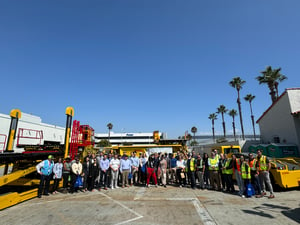
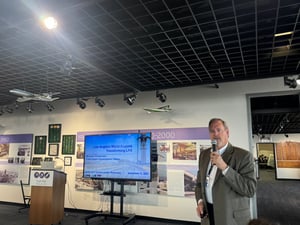
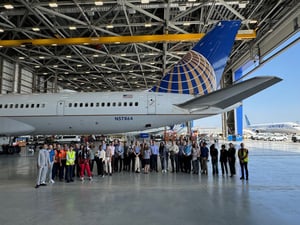
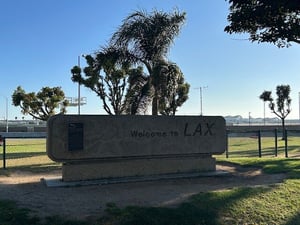
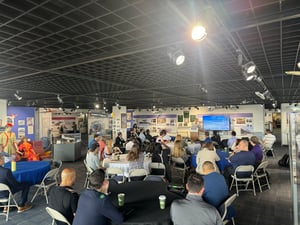
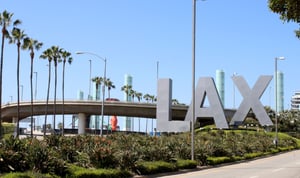
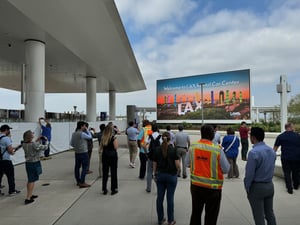
Join ACT
Our Airport Consortium on Transformation is focused on evaluating, coordinating, and launching programs in airports to accelerate the adoption of innovative solutions. The collaborative efforts between airport members and corporate partners have allowed the industry to rapidly share results and implement new technologies.
